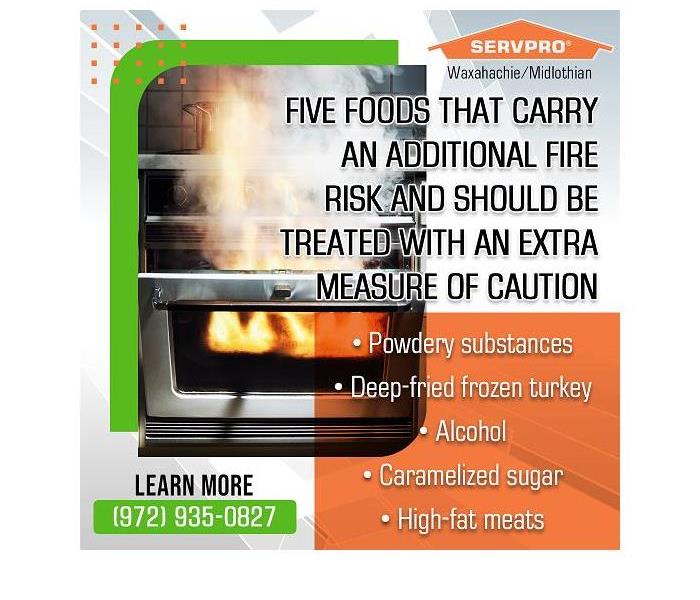Five Foods That Can Cause Fire Damage in Midlothian, TX, Homes
11/24/2021 (Permalink)
Blog Summary: SERVPRO of Waxahachie/Midlothian highlights potentially flammable foods that can lead to a kitchen fire.
As professionals in the fire damage restoration industry, the technicians at SERVPRO of Waxahachie/Midlothian are well aware of the dangers of cooking. The National Fire Protection Association (NFPA) reports, “Cooking equipment is the leading cause of home fires and fire injuries, causing 49% of home fires that resulted in 21% of the home fire deaths and 44% of the injuries.”
Many fire damage disasters in the kitchen are caused by leaving food unattended. However, even an attentive cook can accidentally cause fire damage by cooking with flammable foods. Listed below are five foods that carry an additional fire risk and should be treated with an extra measure of caution.
#1: Powdery substances
Non-dairy creamer, flour, corn starch, powdered sugar, and similar products are highly flammable. Firefighter Insider explains, “The finely ground powder can easily disperse in the air and when it does, it has a very high oxygen to surface area ratio, and it can catch fire in the presence of a naked flame or even with a spark. If there is enough powder present, it could even explode….Powders are flammable because the particles in them have a very small volume and a comparatively large surface area. This surface area is completely exposed to oxygen in the air and thus, it’s very easy for them to catch fire when dispersed in the air. More surface area means higher oxygen to fuel ratio and this means it is more likely to ignite...”
#2: Deep-fried frozen turkey
A notoriously dangerous dish, deep-fried turkey is infamous for causing fires and explosions, especially during the holiday season when turkey is most popular. In fact, the NFPA cautions home cooks that Thanksgiving Day sees three times more cooking-related fires than any other day of the year.
The fire hazard stems from the following two factors:
- The combination of oil and water: Since oil and water molecules repel each other, ice from a frozen turkey and oil from a deep fryer create the potential for an inferno.
- The airborne compounds released at the smoke point of cooking oil: The smoke point, also called the burning point, refers to the temperature at which oil starts to produce smoke, as well as airborne compounds that are highly flammable. Different types of cooking oils reach their smoke points at different temperatures, so cooks should research the smoke point of the oil they have chosen for deep frying. Black smoke coming from the oil in a deep fryer is a warning sign that the oil is nearing its smoke point. Lower the temperature of the fryer immediately.
#3: Alcohol
From sherry to beer, alcohol is a powerful way to elevate the flavor profile of a dish. However, alcohol is also a powerful fire accelerant. Alcohol-infused recipes, such as chicken marsala or beer-battered fish, are delicious and enjoyable to cook, but the chef should be careful not to leave the bottle or can of alcohol too close to the stovetop. Also, be prepared to extinguish any flare ups, which can result from recipes that include alcohol. Be especially cautious when making dishes designed to be lit on fire like shrimp flambé, bananas foster, and cherries jubilee. The combination of alcohol and fire could be disastrous.
#4: Caramelized sugar
One of the hazards of recipes that call for caramelized sugar is the potential for burning the sugar. Properly melting sugar without burning it can be a challenging task, and home cooks need to know how to safely deal with a flaming pan.
#5: High-fat meats
Meats with a high fat content, such as bacon, ribs, lamb chops, and ground beef, release grease when cooked. If this grease escapes the pan, it can badly burn the chef, or it can flare up if exposed to an open flame.
To prevent a grease fire, use a pan that has enough depth to contain all the grease. When cooking bacon, pour the old grease out of the pan before starting a new batch of meat. This oil should be stored in a bowl or jar that is kept away from the stove and other cooking implements.
When a relaxing evening of trying new recipes turns into a stressful kitchen fire, the crestfallen chef may be confused and unsure how to proceed. In the event of fire damage, the local community knows to call the team at SERVPRO of Waxahachie/Midlothian to remediate both fire damage and any secondary damage. The technicians provide a quick response, use state-of-the-art equipment and techniques, and thoroughly complete the restoration process.
To learn more about fire damage restoration services in Midlothian, TX, contact SERVPRO of Waxahachie/Midlothian by email at acarey@SERVPRO10932.com. Staff can also be reached by phone at (972) 935-0827.



 24/7 Emergency Service
24/7 Emergency Service
